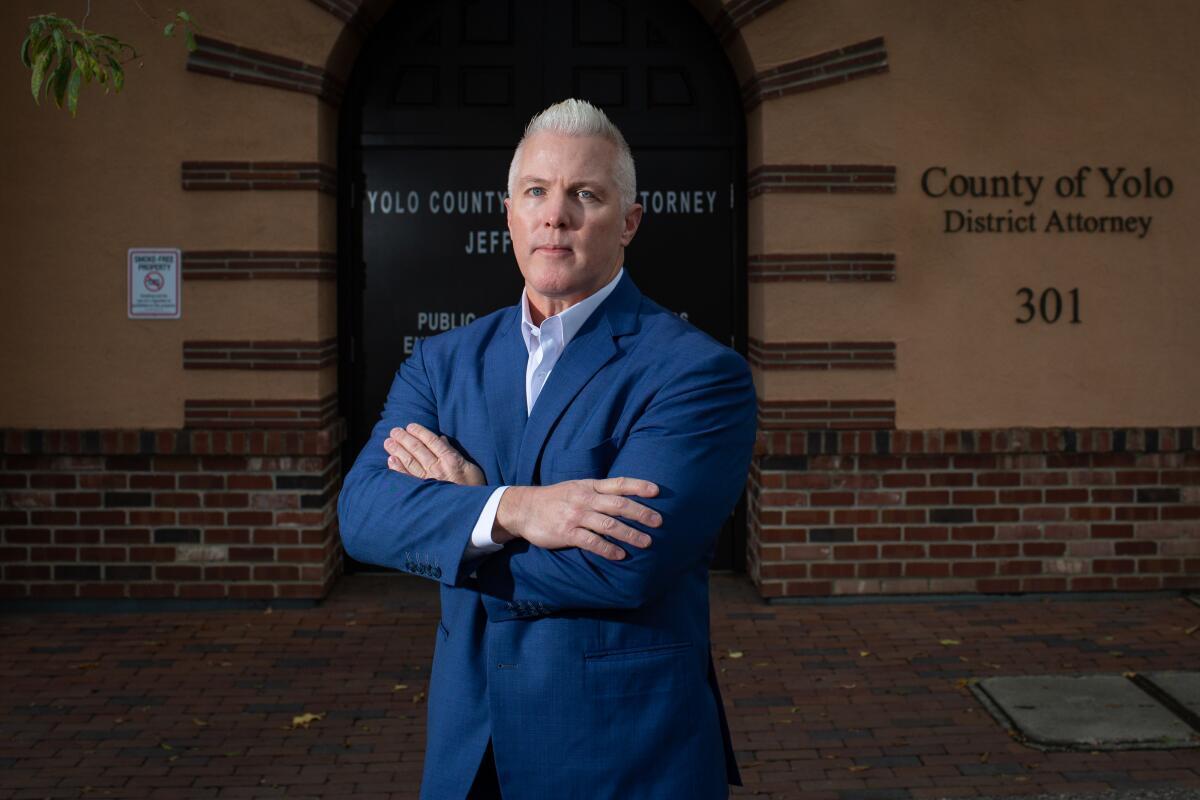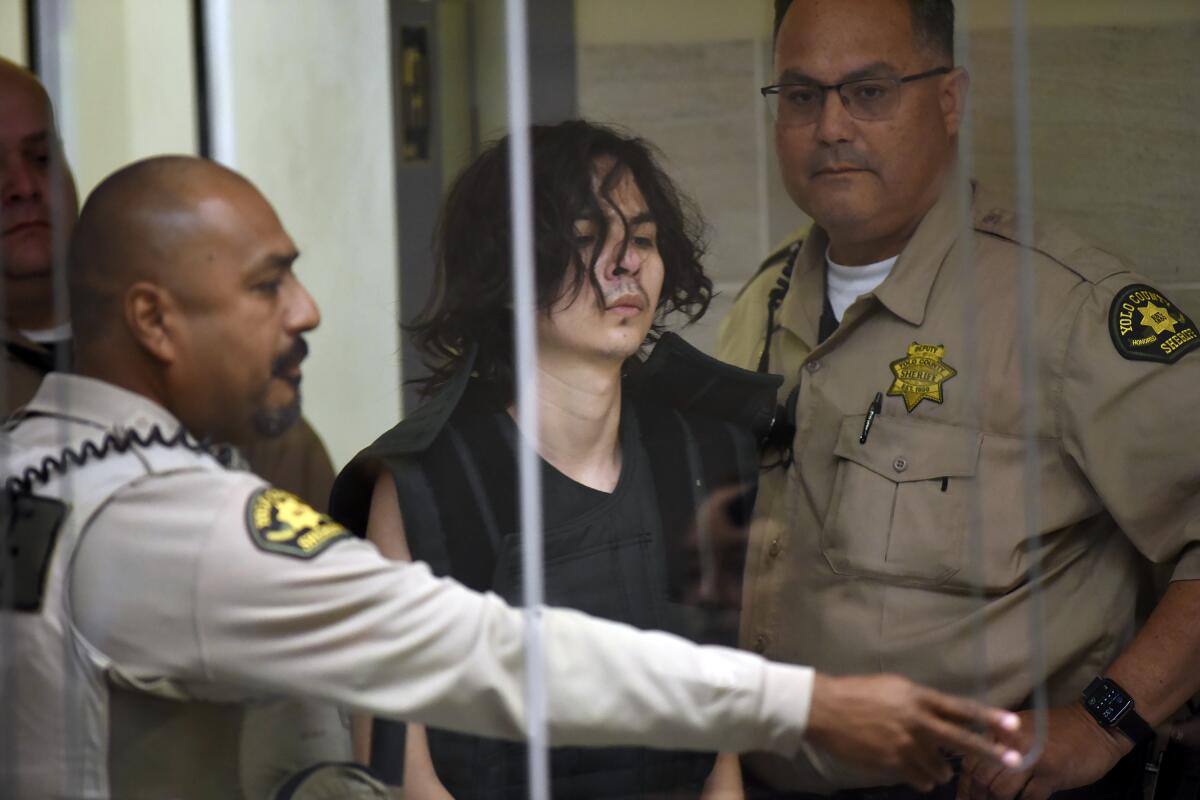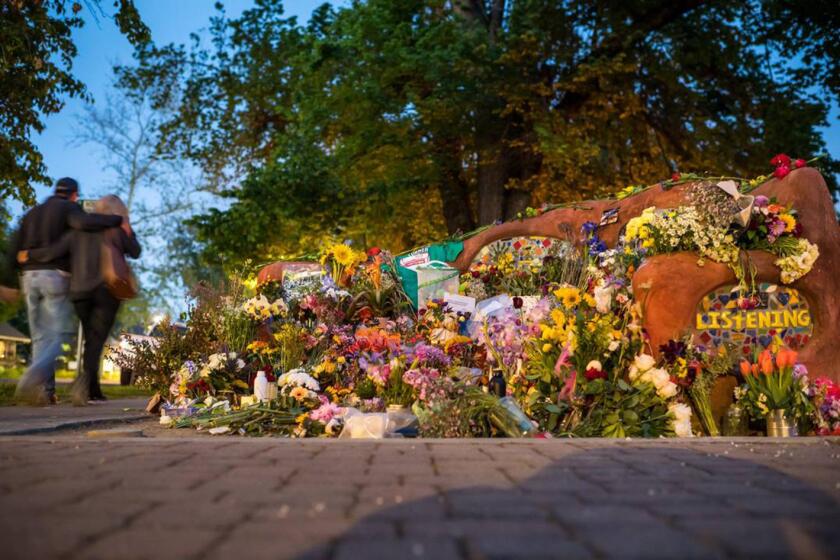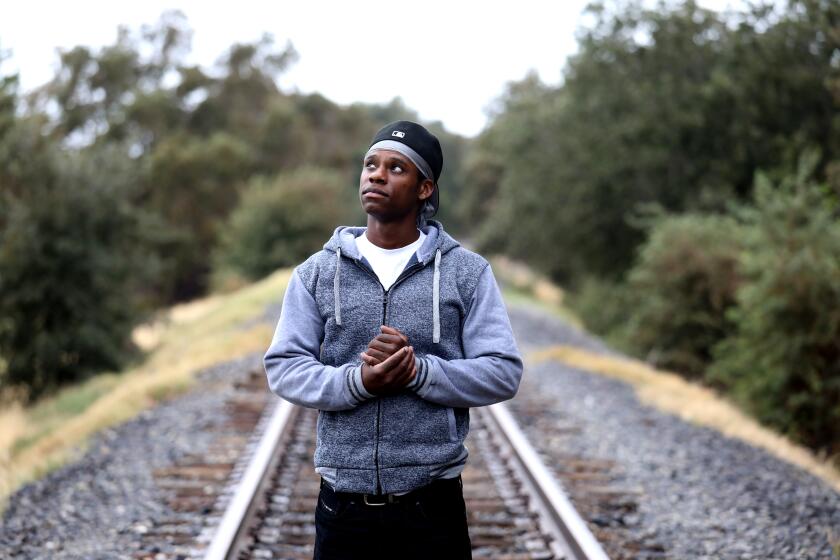Column: Newsom halted the death penalty. The D.A. in the Davis stabbings case doesn’t care

WOODLAND, Calif. — In Yolo County, just west of Sacramento, the decision on whether to pursue the death penalty rests with one man, Dist. Atty. Jeff Reisig.
Of course, the same is true in California’s other 57 counties, where district attorneys ultimately make the call. But, as Reisig told me when I sat down with him recently, “It’s absolutely fair to say that in 58 counties in California, every D.A. probably does it differently.”
Reisig may soon be facing that decision yet again, for about the 30th time in his more than 16 years in office, in the case of the young man accused in a series of stabbings that terrorized the nearby college town of Davis. Over the course of a few days in April, two men were killed and a woman was knifed through the fabric of her tent, leaving her alive but in critical condition.
The suspect in the unexplained spate of violence is 21-year-old Carlos Reales Dominguez, a former UC Davis student who has pleaded not guilty and remains in custody in the Yolo County jail.

It’s the kind of frightening and inexplicable case that leaves many of us split on what justice could look like if Dominguez is eventually found competent to stand trial — especially in a state where the death penalty remains on the books, but is impossible in practice since Gov. Gavin Newsom put a moratorium on it with an executive order in 2019 and shuttered the state’s death chamber at San Quentin State Prison.
So I asked Reisig how he’ll decide — and why.
Reisig can’t speak in specific terms about the Dominguez case, of course, but he was willing to walk me through the process he uses in general, and how both the law and the sentiments of Yolo residents weigh into it.
First off, he told me he doesn’t care about Newsom’s executive freeze.
In fact, Reisig said he considers it an authoritarian overreach for the governor to insert himself into the death penalty debate after voters in both 2012 and 2016 decided to keep the option on the books. He points out that another governor could reverse Newsom’s order, though in dark-blue California, that is unlikely.
The moratorium “has no basis, no influence on whether or not I’m going to do my job,” Reisig said. “If the voters, you know, are given another chance on an initiative and they reject [the death penalty], so be it. That’s democracy. But what we’re living through right now, with the governor’s self-imposed moratorium, I think, is really not democracy.”
Reisig pointed out that only a few types of cases qualify for the death penalty — most commonly first-degree capital murder cases with a narrow set of special circumstances such as lying in wait or killing a police officer. So the first part of his decision is just running though the law to see if a case qualifies.
On the surface, this case could, given the charges. But at a recent court hearing, a judge ordered a mental competency evaluation for Dominguez, and he unsuccessfully asked to represent himself. That first competency hearing will take place on June 20 and will likely begin a lengthy process of determining his fitness for trial.
The brutal stabbings in Davis place a spotlight on how families cope with grievous loss and the complexities of human compassion.
For Reisig, if a suspect is determined to have a mental illness that played a significant role in the commission of the crime, he won’t pursue capital punishment. He considers it “profoundly” wrong to seek the death penalty for someone who can’t understand their actions, which seems obvious. But I promise you some D.A.s would contest a finding of mental incompetency no matter what.
If the mental competency is there and the case qualifies legally, Reisig begins his own internal investigation that looks not just at the crime, but circumstances that make it worse than the average capital murder (aggravating factors), as well as mitigating factors such as whether the person was under duress that may offer some explanation.
He also considers the “special K” evidence, named after its position in the applicable penal code, that’s basically a catch-all for anything else that’s relevant.
“And for that, you literally go back to birth,” he said. “You look at, has this person demonstrated violence throughout their life? Are they a Charles Manson kind of guy? Or is it just like a one and done?”
Though criminal justice reforms have emphasized rehabilitation over long sentences in recent years, for those convicted in harsher eras, second chances are hard to come by.
Interestingly, while a D.A. can consider age in the final decision, age isn’t considered a mitigating factor — meaning suspects don’t get a break just because they’re youthful.
“Just the fact that somebody is young, in their 20s or whatever, does not mean by law that [they’re] not eligible for or not appropriate for the death penalty,” he said.
Once all that evidence is gathered, he brings together his top advisors and they hash it out. “We talk about it, we debate it,” he told me. “We dig, we ask more questions. Sometimes those conversations can take hours, sometimes it’s days, sometimes we’re thinking about it over, you know, weeks.”
But once that team makes a recommendation, “I make the decision,” he said.
Part of that final call is whether he thinks he can win at trial.
Reisig calls Yolo “the most liberal county from Bakersfield to the Oregon border.” That’s one of the reasons that in his nearly two decades as its top prosecutor he has chosen to pursue the death penalty only one time: in the 2008 murder of Yolo County Sheriff’s Deputy Jose Antonio Diaz (though he inherited a death penalty case from his predecessor as well).
“That’s come up a lot, where the case on its face, we all can look at it and say, ‘Yeah, this guy is really the extreme. Like he’s a psychopath. This is terrible. He meets all the statutory elements.’ But will a jury of Yolo County folks go for that? And that, I mean, that changes county to county, right?”
Reisig said that because “people have such entrenched views” on the death penalty, it can be hard to even seat a jury on a capital case. He points out that, legally, a juror has to be willing to consider either life without the possibility of parole or the death penalty. “Well, good luck,” he said of finding jurors open to weighing both.
“People come in and they’re like, ‘No, I will never vote for the death penalty,’ or ‘This guy, this person should always get the death penalty,’” he said. “And so I don’t want to pursue a death sentence on somebody that I know, based on my experience, I have no chance of getting 12 people to agree.”
In the case of Diaz’s murder, Reisig won a death penalty conviction in 2011 against Marco Topete after a jury deliberated for days. Reisig said he and the defense team screened more than 600 jurors before seating their panel — a tough task in a county of about 200,000 people.
In the case he inherited from a previous district attorney, the 2005 killing of CHP Officer Andy Stevens, the jury took only two days to decide on the death penalty for Brendt Anthony Volarvich, then 22 and a member of a white pride gang called the Peckerwoods.
Before I left, I asked Reisig if he is for or against the death penalty, and he told me it’s not about his personal beliefs, though “if the people voted to do away with the death penalty, I’m not going to lose any sleep over it.”
Personally, I am against it precisely because there’s so much discretion in how it is applied. How can we ever feel confident it’s fair, regardless of the moral debate?
Support for the death penalty has fallen dramatically across the country, according to the Death Penalty Information Center, as have the number of executions and death sentence convictions. In 1999, executions reached their highest annual number with 98 people put to death. Death sentences peaked a few years earlier in 1996, with 315 death sentence convictions. In 2022, there were 18 executions, and 20 new death sentences were handed down across the U.S.
Two of those 2022 death sentences were in California, and nearly 700 people (including more than 20 women) are living under death sentences here.
But California voters remain ambivalent about changing our law. A 2021 UC Berkeley poll examining the possibility of putting the issue in front of voters again found 44% said they would vote to repeal the state’s death penalty law, 35% would vote to keep it and 21% remained undecided.
So, as Reisig points out, the death penalty may be sparingly used, but it’s on the books and prosecutors will continue to consider it. That means regardless of where each of us stands, Reisig’s transparency is important — it allows us to understand how these life and death decisions are made.
Because they are still being made, every day, across California.
More to Read
Sign up for Essential California
The most important California stories and recommendations in your inbox every morning.
You may occasionally receive promotional content from the Los Angeles Times.













